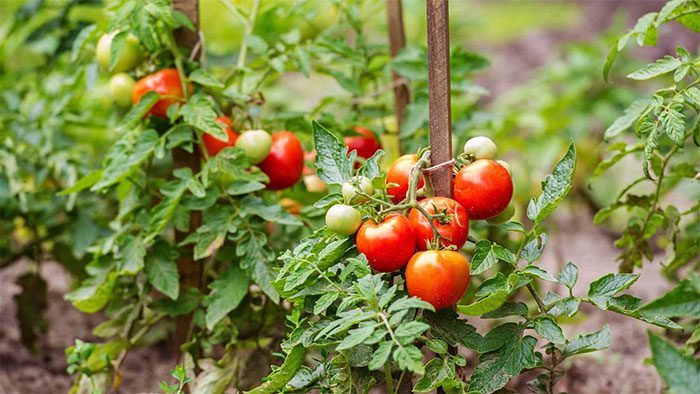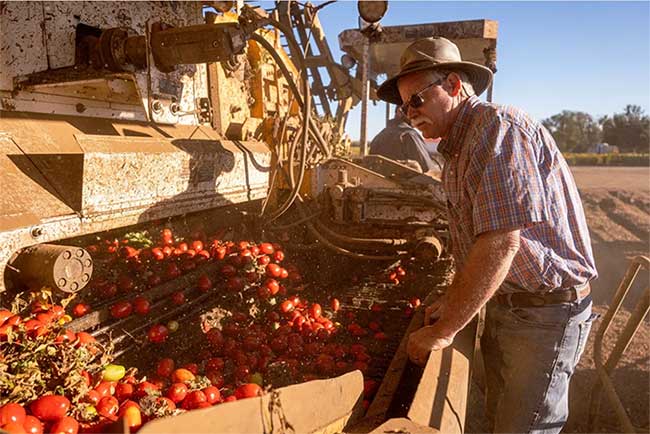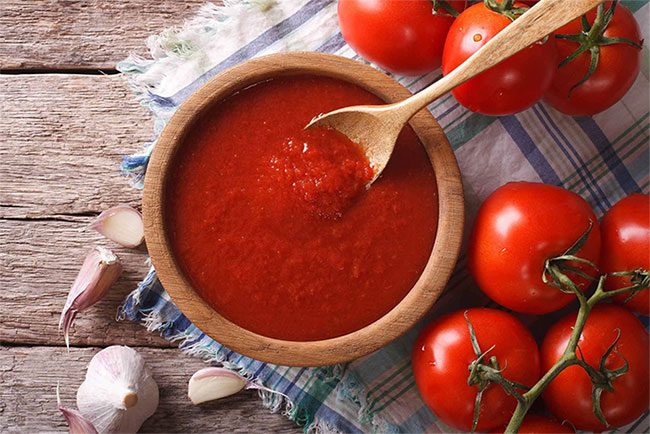The United States may face a crisis related to tomato products.
A restaurant in California is bustling during lunchtime. This establishment offers a wide variety of dishes, with pizza being the standout. One of the essential ingredients for this restaurant is tomato sauce.
Sonu Chatha, the restaurant owner, stated: “Most of my business relies on tomatoes. From pizza sauce to sandwiches, we use tomatoes in everything“.
However, tomatoes and tomato-based products may face severe shortages in the coming months due to prolonged drought conditions in California. As the largest supplier of tomatoes in the U.S., this shortage is sure to drive up the prices of tomato-related products.

Tomatoes are widely used in cooking.
Chatha expressed concern: “It’s frightening to think about the future. We will have to cut back on many menu items. Hopefully, things will adjust accordingly“.
Tomatoes – A Vulnerable Fruit
By 2050, the tomato yield in the U.S., China, and Italy, the three largest “tomato hubs” in the world, is estimated to decrease by 6%, according to a study published in the journal Nature Food.
California produces 90% of the tomato products in the U.S. Previously, this fruit thrived in California’s mild climate. However, rising temperatures in the state are now impacting tomato yields. This fruit is known to be particularly “vulnerable” to the effects of climate change.
Tom Turini, a farm advisor at the University of California, noted that under extreme heat conditions, the rate of flowers on tomato plants developing into fruit is lower. Increasing temperatures also negatively affect irrigation systems, leading California to face chronic water shortages.

Tomato farming is facing challenges in the U.S.
In California, two main water sources are typically used for irrigating tomato plants: groundwater pumped from aquifers and melting snow from the Sierra Nevada mountains. However, the quantity and quality of water have deteriorated over the years. Snowpack levels in the Sierra Nevada have been decreasing.
Additionally, tomato farmers in California are facing other challenges, such as pests and crop diseases. Meanwhile, fertilizer prices are also rising in line with global trends.
Stacked Challenges
The severe drought in California is leaving farmers without enough water to grow tomatoes. Mike Montna, head of the California Tomato Growers Association, told Bloomberg News: “We desperately need rain. We are approaching a point where there will be no inventory to meet market demand“.
Rising fuel and fertilizer costs are also making it difficult for tomato growers to manage their operations. Inflationary pressures combined with the climate crisis are putting farmers in a tough spot.
Montna added: “It’s hard to grow a tomato plant right now. On one hand, drought affects costs because there isn’t enough water for planting, and on the other, inflation is driving up input costs for tomatoes“.

Farmers are struggling as tomato farming becomes increasingly difficult.
Not only farmers but consumers are also directly bearing the consequences of this situation. Ingomar Packing Co., a leading tomato processor in the U.S., has sold tomato ketchup to industry buyers at prices 80% higher than last year.
R. Greg Pruett, the company’s business director, stated: “There simply aren’t enough tomatoes grown this year to meet consumer demand. Water is too expensive, and nothing is cheap anymore“.
According to Bloomberg, the price increases for tomato sauce and ketchup are far exceeding the overall food inflation rate in the U.S., which is at its highest in 43 years. As of August, retail prices for tomato sauce were up 17% from last year, while ketchup prices rose by 23%, based on analysis from market research firm IRI.

Tomato-based products are increasingly rising in price.
Future Solutions
Farmers and researchers are experimenting with various methods to address this issue. They may implement more scientific irrigation practices and eliminate less profitable crops to maintain tomato production.
Researchers have considered relocating tomato cultivation to Washington and Northern California. Of course, this relocation comes with many challenges.
Currently, tomato plants are grown primarily around processing facilities, which helps reduce fuel and transportation costs while providing access to water, energy, and skilled labor.
If the cultivation area for tomatoes changes, producers will have to bear additional costs. Another immediate solution is importing tomatoes, but this is not sustainable.
Italy serves as a prime example, being one of the world’s major tomato hubs. However, there have been times when the country had to import more tomatoes from Spain, Germany, and other places. This becomes more costly due to transportation and contributes to environmental pollution.
Despite the challenges ahead, some researchers remain optimistic about the future. They suggest that there are still many regions with good land and a temperate climate suitable for tomato cultivation, which can help offset the current shortfall.





















































